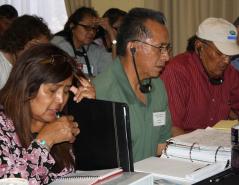*A group of 33 students were competively selected to earn free certification from the UA’s Navajo Interpreter Training Institute to gain eligibility to serve as interpreters in New Mexico and Arizona state courts.*
Many of the 33 students enrolled in the University of Arizona’s Navajo Interpreter Training Institute have similar backgrounds – they began their unofficial role as English-to-Navajo language interpreters as children translating for their parents and grandparents.
Now, as adults who live and work across Arizona and New Mexico, they still find themselves providing the same service.
The UA’s National Center for Interpretation on Sunday ended a six-day training institute to prepare the group as part of the first steps needed to become certified Navajo/English court and medical interpreters and to help ensure equal access for healthcare and justice for limited or non-English speaking Navajos.

Rick Nez (center) recalls childhood memories of interpreting for his parents and grandparents. Today, he serves as the chapter president of San Juan, New Mexico and recently worked to gain certification from the UA's Navajo Interpreter Training Institute. Image credit: University of Arizona
The training includes an overview of legal procedures, which was taught by federally certified court Interpreters, university professors and attorneys. Students who committed to the 56-hour training received a certificate of completion and information to continue in the certification process toward becoming eligible for employment in Arizona and New Mexico state courts and other agencies.
The 33 students were competitively selected from a group of more than 140 applicants. And thanks to generous support from the University of New Mexico’s Institute of Public Law Judicial Education Center and also contributions by the UA Center Agnese Haury Institute for Interpretaton, the training was free, said Armando Valles, assistant director at the UA National Center for Interpretation.
However, because of rising costs and no more assistance from previous funders including the Arizona Supreme Court, fundraising is essential to the program’s continuation and success.
The UA center is responsible for the development and administration of the nation’s benchmark programs in specialized interpreter testing and training: the Federal Court Interpreter Certification Exam and the Agnese Haury Institute for Interpretation. Both programs were developed in 1983 by Roseann Gonzalez, the institute’s co-founder and director, along with assistance from philanthropist Agnese Nelms Haury and its offspins: the Medical Interpreter Training Institue in 1999 as well as the Navajo Training Institute, established in 1993.
“It is absolutely critical that the interpretation be correct even one incorrect word can change a medical diagnosis or treatment or lead to a wrongful conviction,” said Casey Watchman, an instructor for the institute. During the six-day training, Watchman works directly with the students to ensure the accuracy and quality of the interpretation, both in Navajo and in English.
Karen Frances-Begay, special advisor to UA president Robert N. Shelton on American Indian Affairs, said the training is one of the few language preservation programs for Navajos. The program also serves as a sorely needed resource for its community members, Frances-Begay added.
One of the students was Perphelia Fowler, a native Navajo speaker from the Navajo Nation who lives just north of Ganado, Ariz., Fowler works as a health care administrator where she spends most of her day interpreting for her employer to fellow employees and for the Navajo patients they treat.
Fowler said the physicians and providers she works with have found it difficult to find trained Navajo interpreters.
“In a health care setting there are many opportunities for misdiagnosis stemming from miscommunication. From personal experience in my community, there is a strong need to have clear communication from Navajo to English and English to Navajo,” Fowler said.
Fowler said she looks forward to returning and sharing her new knowledge with colleagues and to continuing on with her certification.
Another trainee, Rick Nez, said he interpreted for his parents and grandparents as a child, often at the local trading post as well as for Christian missionaries on the Navajo reservation.
Currently, Nez serves as the chapter president of San Juan, New Mexico – the equivalent of being mayor of the community. He said his current public service role and the public meetings made him realize the importance of being able to properly communicate to the elder members. This drove him to apply for the training.
“I thought I knew the Navajo language and now recognize how important its proper use is,” Nez said. “I now plan on sitting in on federal and local courtroom sessions to observe and build on my vocabulary to continue learning to gain certification.”
– By Rebecca Ruiz-McGill
*Source: University of Arizona
